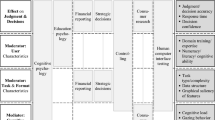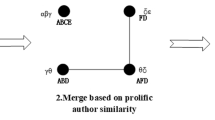Abstract
Projection measure is one of the most important tools for group decision-making (GDM) problems. However, this research finds that the existing projection measure is not always reasonable in interval-valued intuitionistic fuzzy setting. To solve this problem, this research intends to (1) propose a new normalized projection measure in interval-valued intuitionistic fuzzy setting; (2) develop a GDM model based on the new projection measure; and (3) apply the developed model to evaluating knowledge transfer effectiveness for software development team. The feasibility and practicability developed method in this work are illustrated by an experimental analysis.












Similar content being viewed by others
References
Tian Z, Zhang H, Wang J, Wang J, Chen X (2016) Multi-criteria decision-making method based on a cross-entropy with interval neutrosophic sets. Int J Syst Sci 47(15):3598–3608
Peng X, Liu C (2017) Algorithms for neutrosophic soft decision making based on EDAS, new similarity measure and level soft set. J Intell Fuzzy Syst 32(1):955–968
Rezaeisaray M, Rezaeisaray M, Ebrahimnejad S, Ebrahimnejad S, Khalili-Damghani K, Khalili-Damghani K (2016) A novel hybrid MCDM approach for outsourcing supplier selection: a case study in pipe and fittings manufacturing. J Modell Manag 11(2):536–559
Zavadskas EK, Bausys R, Juodagalviene B, Garnyte-Sapranaviciene I (2017) Model for residential house element and material selection by neutrosophic MULTIMOORA method. Eng Appl Artif Intell 64:315–324
Zavadskas EK, Bausys R, Kaklauskas A, Ubarte I, Kuzminske A, Gudiene. N (2017) Sustainable market valuation of buildings by the single-valued neutrosophic MAMVA method. Appl Soft Comput 57:74–87
Deli I (2015) NPN-soft sets theory and their applications. Ann Fuzzy Math Inform 10(6):847–862
Deli FI, Smarandache B (2014) Interval valued neutrosophic parameterized soft set theory and its decision making. J New Results Sci 7:58–71
Yoon Y, Hastak M, Cho K (2017) Preference clustering-based mediating group decision-making (PCM-GDM) method for infrastructure asset management. Expert Syst Appl 83:206–214
Yue Z (2013) Group decision making with multi-attribute interval data. Inf Fus 14(4):551–561
Yue Z (2013) An avoiding information loss approach to group decision making. Appl Math Model 37(1–2):112–126
De Miguel L, Sesma-Sara M, Elkano M, Asiain M, Bustince H (2017) An algorithm for group decision making using n-dimensional fuzzy sets, admissible orders and OWA operators. Inf Fus 37:126–131
Kabak Ö, Ervural B (2017) Multiple attribute group decision making: a generic conceptual framework and a classification scheme. Knowl Based Syst 123:13–30
Yue C (2018) A novel approach to interval comparison and application to software quality evaluation. J Exp Theor Artif Intell. https://doi.org/10.1080/0952813X.2018.1430864
Paul Yoon K, Kyung Kim W (2017) The behavioral TOPSIS. Expert Syst Appl 89:266–272
Pouresmaeil H, Shivanian E, Khorram E, Fathabadi HS (2017) An extended method using TOPSIS and VIKOR for multiple attribute decision making with multiple decision makers and single valued neutrosophic numbers. Adv Appl Stat 50(4):261–292
Akbaş H, Bilgen B (2017) An integrated fuzzy QFD and TOPSIS methodology for choosing the ideal gas fuel at WWTPs. Energy 125:484–497
Walczak D, Rutkowska A (2017) Project rankings for participatory budget based on the fuzzy TOPSIS method. Eur J Oper Res 260(2):706–714
Sellak H, Ouhbi B, Frikh B, Palomares I (2017) Towards next-generation energy planning decision-making: an expert-based framework for intelligent decision support. Renew Sustain Energy Rev 80:1544–1577
Yue Z (2014) TOPSIS-based group decision-making methodology in intuitionistic fuzzy setting. Inf Sci 277:141–153
Chai J, Liu JNK, Ngai. EWT (2013) Application of decision-making techniques in supplier selection: a systematic review of literature. Expert Syst Appl 40(10):3872–3885
Zyoud SH, Fuchs-Hanusch D (2017) A bibliometric-based survey on AHP and TOPSIS techniques. Expert Syst Appl An Int J 78(C):158–181
Yue Z (2013) An intuitionistic fuzzy projection-based approach for partner selection. Appl Math Model 37(23):9538–9551
Yue Z (2014) A group decision making approach based on aggregating interval data into interval-valued intuitionistic fuzzy information. Appl Math Model 38(2):683–698
Atanassov K, Gargov G (1989) Interval valued intuitionistic fuzzy sets. Fuzzy Sets Syst 31(3):343–349
Atanassov KT (1986) Intuitionistic fuzzy sets. Fuzzy Sets Syst 20(1):87–96
Liu P (2017) Multiple attribute group decision making method based on interval-valued intuitionistic fuzzy power Heronian aggregation operators. Comput Ind Eng 108:199–212
Chen S-M, Huang Z-C (2017) Multiattribute decision making based on interval-valued intuitionistic fuzzy values and particle swarm optimization techniques. Inf Sci 397:206–218
Yue C (2016) A geometric approach for ranking interval-valued intuitionistic fuzzy numbers with an application to group decision-making. Comput Ind Eng 102:233–245
Chen S-M, Cheng S-H, Tsai W-H (2016) Multiple attribute group decision making based on interval-valued intuitionistic fuzzy aggregation operators and transformation techniques of interval-valued intuitionistic fuzzy values. Inf Sci 367:418–442
Hashemi SS, Razavi Hajiagha SH, Zavadskas EK, Mahdiraji HA (2016) Multicriteria group decision making with ELECTRE III method based on interval-valued intuitionistic fuzzy information. Appl Math Model 40(2):1554–1564
Nguyen H (2016) A new interval-valued knowledge measure for interval-valued intuitionistic fuzzy sets and application in decision making. Expert Syst Appl 56:143–155
Yue Z, Jia Y (2017) A projection-based approach to intuitionistic fuzzy group decision making. Sci Iran 24(3):1505–1518
Yue C (2016) A model for evaluating software quality based on symbol information. J Guangdong Ocean Univ 36(1):85–92
Tsao C-Y, Chen T-Y (2016) A projection-based compromising method for multiple criteria decision analysis with interval-valued intuitionistic fuzzy information. Appl Soft Comput 45:207–223
Liu X, Zhu J, Liu S (2014) Bidirectional projection method with hesitant fuzzy information. Syst Eng Theory Pract 34(10):2637–2644
Wang Q, Fang Z, Zhang N, Shi H (2015) A two-tuple linguistics muti-attribute group decision making based on bi-directional projection operator. Math Pract Theory 20:44–51
Cai F, Gao X, Liu M, Liu X, Han L, Chen J (2011) GRAP: Grey risk assessment based on projection in ad hoc networks. J Parallel Distrib Comput 71(9):1249–1260
Zheng G, Jing Y, Huang H, Gao Y (2010) Application of improved grey relational projection method to evaluate sustainable building envelope performance. Appl Energy 87(2):710–720
Zeshui X, Da Q (2004) Projection method for uncertain multi-attribute decision making with preference information on alternatives. Int J Inf Technol Decis Mak 3(03):429–434
Zeshui X (2005) On method for uncertain multiple attribute decision making problems with uncertain multiplicative preference information on alternatives. Fuzzy Optim Decis Mak 4(2):131–139
Zeshui X, Hui H (2010) Projection models for intuitionistic fuzzy multiple attribute decision making. Int J Inf Technol Decis Mak 9(2):267–280
Wang J, Li K, Zhang H (2012) Interval-valued intuitionistic fuzzy multi-criteria decision-making approach based on prospect score function. Knowl Based Syst 27:119–125
Gai Li Xu and Fang Liu (2013) An approach to group decision making based on interval multiplicative and fuzzy preference relations by using projection. Appl Math Model 37(6):3929–3943
Yue Z (2012) Application of the projection method to determine weights of decision makers for group decision making. Sci Iran 19(3):872–878
Yue Z (2012) Approach to group decision making based on determining the weights of experts by using projection method. Appl Math Model 36(7):2900–2910
Zeng S, Baležentis T, Chen J, Luo G (2013) A projection method for multiple attribute group decision making with intuitionistic fuzzy information. Informatica 24(3):485–503
Yue Z, Jia Y (2015) A group decision making model with hybrid intuitionistic fuzzy information. Comput Ind Eng 87:202–212
Wei G, Alsaadi FE, Hayat T, Alsaedi A (2016) Projection models for multiple attribute decision making with picture fuzzy information. Int J Mach Learn Cybern 9:713–719
Dev PP, Pramanik S, Giri BC (2016) Neutrosophic soft multi-attribute decision making based on grey relational projection method. Neutrosophic Sets Syst 11:98–106
Yanbing J, Wang A (2013) Projection method for multiple criteria group decision making with incomplete weight information in linguistic setting. Appl Math Model 37(20):9031–9040
Yue C (2017) Two normalized projection modfels and application to group decision-making. J Intell Fuzzy Syst 32(6):4389–4402
Chuan Y (2017) Normalized projection approach to group decision-making with hybrid decision information. Int J Mach Learn Cybern. https://doi.org/10.1007/s13042-017-0650-3
Yue Z, Jia Y (2017) A direct projection-based group decision-making methodology with crisp values and interval data. Soft Comput 21(9):2395–2405
Yue C (2017) Entropy-based weights on decision makers in group decision-making setting with hybrid preference representations. Appl Soft Comput 60:737–749
Atanassov K (1986) Intuitionistic fuzzy sets. Fuzzy Sets Syst 20(1):87–96
Zeshui X, Chen J (2007) An approach to group decision making based on interval-valued intuitionistic judgment matrices. Syst Eng Theory Pract 27(4):126–132
Yue Z, Jia Y (2013) An application of soft computing technique in group decision making under interval-valued intuitionistic fuzzy environment. Appl Soft Comput 13(5):2490–2503
Deli I, Eraslan S, Çğaman N (2018) ivnpiv-Neutrosophic soft sets and their decision making based on similarity measure. Neural Comput Appl 29:187–203
Uluçay V, Deli I, Şahin M (2018) Similarity measures of bipolar neutrosophic sets and their application to multiple criteria decision making. Neural Comput Appl 29(3):739–748
Broumi S, Deli I, Smarandache F (2014) Distance and similarity measures of interval neutrosophic soft sets. Crit Rev 8:11–31
Yue Z (2011) An extended TOPSIS for determining weights of decision makers with interval numbers. Knowl Based Syst 24(1):146–153
Sangaiah AK, Gopal J, Basu A, Subramaniam PR (2017) An integrated fuzzy DEMATEL, TOPSIS, and ELECTRE approach for evaluating knowledge transfer effectiveness with reference to GSD project outcome. Neural Comput Appl 28(1):111–123
Yue Z, Jia Y (2013) A method to aggregate crisp values into interval-valued intuitionistic fuzzy information for group decision making. Appl Soft Comput 13(5):2304–2317
Yue C, Yue Z (2018) A soft approach to evaluate the customer satisfaction in e-retailing. In: Cao BY (eds) Fuzzy information and engineering and decision. IWDS 2016. Advances in intelligent systems and computing, vol 646. Springer, Cham, pp 282–296
Yue Z (2014) Aggregating crisp values into intuitionistic fuzzy number for group decision making. Appl Math Model 38(11–12):2969–2982
Broumi S, Deli I, Smarandache F (2014) Relations on interval valued neutrosophic soft sets. J New Results Sci 5:1–20
Deli I (2016) Refined neutrosophic sets and refined neutrosophic soft sets: theory and applications (Chapter 16). In: Hosny M, Kandil A, El-Tantawy OA, El-Sheikh SA (eds) Handbook of research on generalized and hybrid set structures and applications for soft computing. IGI Global, pp 321–343
Acknowledgements
The author would like to thank the editors and the anonymous reviewers for their insightful and constructive comments and suggestions that have led to this improved version of the paper. This work was supported partially by the Young Creative Talents Project from Department of Education of Guangdong Province (No. 2016KQNCX064), the Education and Teaching Reform Program of Guangdong Ocean University (No. XJG201644) and the Monitoring System Managed by Underwater Robot for Deep Sea Cage Culture (No. GDOU2017052605).
Author information
Authors and Affiliations
Corresponding author
Ethics declarations
Conflict of interest
The author declares that there is no conflict of interests regarding the publication of this article.
Appendix
Appendix
1.1 Related tables in Sect. 6.2
The separations, relative closeness of individual decision and weight of DM based on the traditional projection measure are shown in Table 12.
Three weighted (on DMs) individual decisions based on the traditional projection measure are shown in Table 13.
Four group decisions based on the traditional projection measure are shown in Table 14.
The ideal decisions of four group decisions based on the traditional projection measure are shown in Table 15.
The separations, relative closeness of individual decision and weight of DM based on the projection measure in Eq. (42) are shown in Table 16.
Three weighted (on DMs) individual decisions based on the traditional projection measure are shown in Table 17.
Four group decisions based on the projection measure in Eq. (42) are shown in Table 18.
The ideal decisions of four group decisions based on the projection measure in Eq. (42) are shown in Table 19.
Rights and permissions
About this article
Cite this article
Yue, C. An interval-valued intuitionistic fuzzy projection-based approach and application to evaluating knowledge transfer effectiveness. Neural Comput & Applic 31, 7685–7706 (2019). https://doi.org/10.1007/s00521-018-3571-5
Received:
Accepted:
Published:
Issue Date:
DOI: https://doi.org/10.1007/s00521-018-3571-5




